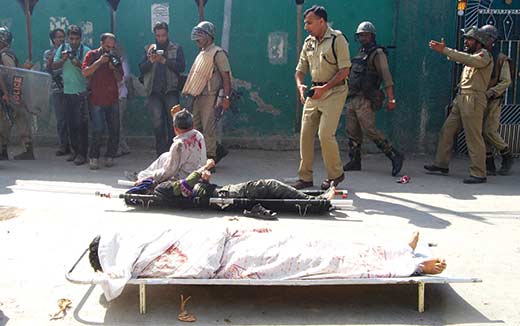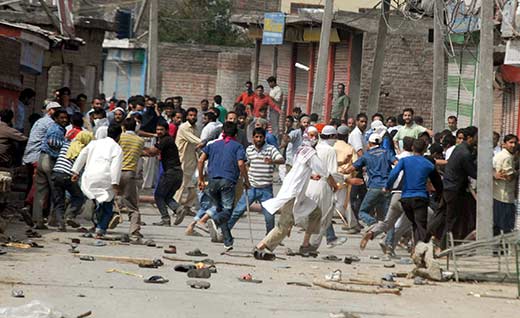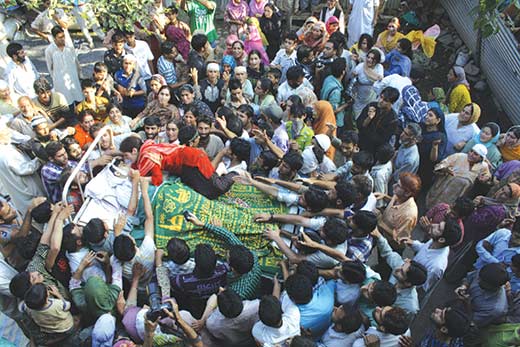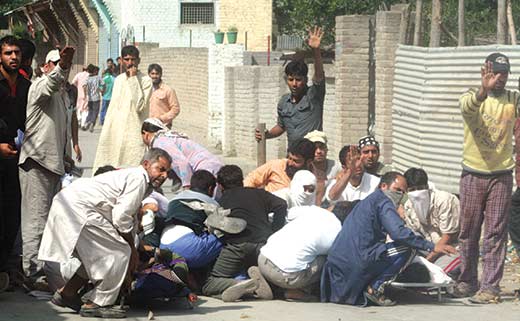As Omar Abdullah announced a fresh probe into the 2010 civil unrest that saw more than a hundred youth dead and scores blinded by the non-lethal set-up. Shah Abbas revisits the crisis that perhaps is one of the worst instances of subverting criminal procedure code
 On January 30, 2010, it happened for the first time in Kashmir. Police Control Room (PCR) Srinagar was properly cleansed, perfumed by incense sticks and rose water sprays to host the Mullas, Molvis and Mutwalis affiliated with different Srinagar Shrines. They were told to perform Khatam-e-Sharief (Special prayer meeting) for peace and tranquillity in the conflict ridden state. The Mullas were offered delicious Wazewan at the end and paid Bakhshis as well.
On January 30, 2010, it happened for the first time in Kashmir. Police Control Room (PCR) Srinagar was properly cleansed, perfumed by incense sticks and rose water sprays to host the Mullas, Molvis and Mutwalis affiliated with different Srinagar Shrines. They were told to perform Khatam-e-Sharief (Special prayer meeting) for peace and tranquillity in the conflict ridden state. The Mullas were offered delicious Wazewan at the end and paid Bakhshis as well.
But the money spent on the event went in vain as it did not yield the desired results and the summer which followed witnessed large scale protests, killings, shutdowns and curfews. The stone pelters did not spare the PCR as well and pelted stones on it. According to sources, police even once detained and beat the youth in the same room where Mullas had prayed for peaceful 2010!
A day after the police hosted the Khatam-e-Sharief, a youth Wamiq Farooq was killed by police in the down town area of Srinagar. The killing evoked severe reaction across Kashmir. At least 150 persons including 50 police and CRPF men sustained injuries in violent clashes that crippled life for five days not only in Srinagar but across all the major towns of the Valley.
The situation started brewing and police arrested alleged 410 stone pelters in March 2010 only. It also managed ‘Bharat Darshan’ for dozens of stone pelters to different metropolitan cities to “change their mind”. Chief minister Omar Abdullah probably sensing the situation had earlier emphasized the need for upgrading the skills of state police to handle law and order situations more effectively. “The traditional methods employed for crowd control require improvement in the light of our experience in Kashmir. I would request the Government of India (GOI) to provide us with the necessary assistance to devise crowd management systems which are suitable for the conditions in the state,” Omar had said addressing the Chief Ministers’ Conference on Internal Security in New Delhi on February 7, 2010. The chief minister was visibly worried as protests of 2008 and 2009 against the Amarnath land transfer and Shopian alleged double rape and murder tragedy respectively, were still fresh in his mind.
State Ministry of Home informed the legislative assembly on February 19, 2014 that 1733 FIRs have been registered against 9166 persons since 2009, in different districts of Kashmir division.
And what followed was something unimaginable. In the words of senior Journalist, Parvaiz Bukhari, “The summer of 2010 witnessed a convulsion in the world’s most militarized zone…..an unprecedented and deadly civil unrest.”
 But the announcement of enquiry into 125 killings during 2010 uprising happened only after the recent poll debacle in which ruling National Conference lost all three seats to rival Peoples Democratic Party (PDP).
But the announcement of enquiry into 125 killings during 2010 uprising happened only after the recent poll debacle in which ruling National Conference lost all three seats to rival Peoples Democratic Party (PDP).
The “curative measure” of Omar led government apparently suggests: had NC won the LS elections there would have been no inquiry at all.
“The Commission of enquiry (COI) will also enquire into the adequacy, or otherwise, of the force used, fix responsibility, wherever excessive force has been used, resulting in fatalities, and where due care has not been taken to avoid such fatalities, suggest measures to avoid the recurrence of such incidents in future and recommend the action to be taken against those found responsible in any such incidents,” said an official statement.
The critique are of the opinion that the “corrective measure” of the Omar led government is grossly misplaced or it is all deliberate and just another “gimmick” to “hoodwink” the people. “After all, some people have mastered the craft here; earlier they would do it by displaying green scarf in public rallies and now by cheap appeasement tactics,” a political commentator said.
“After four years, the decision looks not only ridiculous but appeasement factor makes it more humiliating than the categorical denial of justice. It lacks grace and also underlines the insincerity of the NC led government towards delivering justice to the victims,” Shawkat Ahmad Parray, a political scientist told Kashmir Life.
Even the former chief minister Ghulam Nabi Azad fails to understand why Omar delayed the probe into civilian killings of 2010 unrest. “It will be better if you put this question to the Chief Minister, Omar Abdullah who holds three portfolios — chief minister, head of the government and the home ministry. This was purely state government’s job,” Azad said in response to a question.
The government has not more than six months at its disposal even if we stretch its tenure beyond maximum possible limit. “What it couldn’t do in last four years it is now vowing to do that at the fag-end of its writ,” Shawkat said.
Many say, if the apparent change of heart in the NC leadership is serious then they should probably look into the reasons that prevented any meaningful inquiry into the 2010.
They should also see why justice was not delivered, at the institutional level, into many other such incidents.
According to experts, the cause of the civilian killings in 2010 is not that complicated that we need to repeat the “tradition” of initiating an inquiry.
 “It’s foolish to play naive. An honest admission of the larger problem and its fatal fallout is enough,” Nayeem Ahmad Khan, a separatist leader told Kashmir Life. However, Khan added, “if one fixes the responsibility to bring the culprits to book and deliver justice then it is more meaningful to first remove the institutional glitches that failed the earlier commissions to meet their objectives.”
“It’s foolish to play naive. An honest admission of the larger problem and its fatal fallout is enough,” Nayeem Ahmad Khan, a separatist leader told Kashmir Life. However, Khan added, “if one fixes the responsibility to bring the culprits to book and deliver justice then it is more meaningful to first remove the institutional glitches that failed the earlier commissions to meet their objectives.”
Political commentators believe that Omar led coalition government’s failure to initiate any action against officials allegedly responsible for 125 killing was denting party’s credibility prompting government to assign the time-bound inquiry to a retired High Court judge ML Kaul.
Kaul is already holding an inquiry into the death of three persons in the CRPF firing at Gagren, Shopian on September 7, 2013. Three civilians were killed in CRPF firing while Zubin Mehta was in the summer capital entertaining the elite of the society. Koul has not completed this assignment even after seeking four extensions. Now Koul has started to probe the killings of 125 persons and he has been directed to submit the report by the end of September 2014. Koul has to complete inquiry within the stipulated time in a system which is yet to decide whether Tufail Matoo, was killed by the tear smoke shell or not – even after four years of investigation.
Before assigned to probe Shopian killings, Koul, was once chairman of the Advisory Board meant to review the cases against those languishing under Public Safety Act. “Koul sahib in his tenure of many years never negated even a single government decision of PSA against any person,” a senior officer affiliated with the Advisory Board told Kashmir Life.
Omar government had earlier commissioned an inquiry into the first 17 deaths which took place from June 11, 2010 to other retired judges of J&K High Court Syed Bashir Ul din and retired Y P Nargotra. The government, according to sources, did not agree to grant extension to the said Commission.
Then District Magistrate Islamabad had also ordered a Magisterial Enquiry into the killings of Ishtyaq Ahmad Khanday, Imtiyaz Ahmad Itoo and Shujaat-Ul-Islam on June 26, 2010 at Anchedora, area of South Kashmir, which after some time submitted its report. The state assembly on October 9, 2010 was informed that government has accepted the Magisterial Enquiry report and follow up action on the basis of the report had been initiated.
However, sources said that the report which held a Senior Superintendent of Police and four of his subordinates allegedly responsible for “lapses in the three killings” was dumped in the State Home Department, functioning directly under the Chief Minister.
“The SSP was promoted as Deputy Inspector General of Police and all the upper rank Police officers were promoted to senior positions or granted post-retirement rehabilitation,” sources said.
The locals alleged that Ishtyaq, Imtiyaz and Shujaat were victims of a “target killing”. “The trio was killed in the courtyard of Ahmad-ullah Khanday in the presence of some police officers,” they allege.
Interestingly, throughout 2010, government had maintained, through press releases, that the youth killed in police and CRPF firing were ‘miscreants’. In most of the cases there are FIRs registered against the victims!
Legislative assembly was informed on October 9, 2010 that 19 FIRs had been registered against security forces/police personnel where allegations of unprovoked firing or use of excessive forces were allegedly made.
The chain of killings during 2010 started with the killing of Inayat-ullah-Khan of Dalgate Srinagar on January 8. Subsequently, Parvez Ahmad Hajam of Sopore, Manzoor Ahmad Sofi of Yakman Pora Pattan and Mushtaq Ahmad Mir of Qalampora Pulwama were killed in the month of January alone.
Later, after the killings of Zahid Farooq and Tufail Matoo, the revelation of Machil fake encounter worked as fuel to fire resulting in a full fledged uprising against the Indian rule. Most of the analysts opine that the then separatist face Masarat Alam Bhat, who is languishing behind bars since October 2010, only exploited the public anger by issuing protest calendars.
 Around 100 among those killed in 2010 were under the age group of 30 years including 4 kids of 10 to 12 years of age. They include Sameer Rah (9) of Batamaloo, Meelad Ahmad Dar (9) of Ganderbal, Asif Hussain Rather (10) of Delina Baramullah and Adil Ramzan Sheikh (12) of Palhallan.
Around 100 among those killed in 2010 were under the age group of 30 years including 4 kids of 10 to 12 years of age. They include Sameer Rah (9) of Batamaloo, Meelad Ahmad Dar (9) of Ganderbal, Asif Hussain Rather (10) of Delina Baramullah and Adil Ramzan Sheikh (12) of Palhallan.
The victims also include 5 women namely Afroza Jan, Aisha Begum, Fancy Jan, Hajra Begum and Mubeena Akhtar and 60 years old Habib-ullah-Khan of Dewar Lolab.
Most of the analysts are of the opinion that 2010 uprising was in fact a transition of Kashmiri separatist movement from violence to non-violence means in which masses were involved at full scale. “Little known and relatively anonymous resistance activists emerged, organising an unarmed agitation more fierce than the armed rebellion…….two decades earlier,” writes Parvaiz Bukhari.
For a senior journalist who wished anonymity, in last two and half decades since armed resistance broke out in Kashmir, 2010 was the first instance when Indian government was visibly nervous viz-a-viz Kashmir. It was for the first time that GOI sent an All Party Parliamentary delegation to meet separatists in Kashmir. The high profile visit yielded nothing as most of the separatists, who were freed recently, failed to engage them or get even a single youngster out of lockup.
But yes, Kashmiris were offered “blood money”. The central government announced a “special package” to “silent the annoyed Kashmiris”. Apart from the state government’s relief package vide Government order No. 852-GAD dated July 27, 2010, the central government sanctioned Rs 5 lac to the next of kin killed since June 11, 2010. The central government vide order No. Home 1234 of 2010 dated October 2, 2010 also sanctioned ex-gratia relief to the tune of Rs 5.10 crores in favour of the next of kin of 102 persons, Rs 5 lac each to the next of kin of deceased persons. Under the “special package” for the state, Jammu and Ladakh regions were sanctioned Rs 250 crore each for the development by debit to state own funds.
The “special package” also included the “rehabilitation” of the stone pelters. On spot recruitment drives were started throughout the valley and dozens of youth exclusively from down town area of Srinagar were recruited at one such function held at Khanyar. The famous stone pelters like Mandela of Maisuma were “rehabilitated” and recruited in the police. The state government also claims to have granted amnesty to the stone pelters involved in cases dating back to 2010. But according to family members of alleged stone pelters nothing has happened on ground and their loved ones still languish in different jails across J&K.
“Police officers at the local level run their own governments and they totally negate any amnesty to the protesting youth,” Mohammad Subhan, whose son is wanted in many FIRs, told Kashmir Life, adding, “my son seldom spends night at home.” There are also serious charges of demanding ransom from the victim families by police.
The civilian killings in Kashmir are going on since 1989 but in 2010 hundreds got disabled by the use of “non-lethal weapons” like pellet guns especially after the central delegation submitted its report to New Delhi and it announced the “special package” for Kashmir.
“From now on, you will have to count the disabled persons instead of dead ones,” a police officer (now retired) told a senior Journalist who shared it with Kashmir Life.
Answering a written and joint question of 5 MLAs in the state legislative assembly, the government on October 7, 2010 admitted that 534 civilians were injured in police and forces’ actions since June 2010. “As on October 2, 2010 while 29 persons are undergoing treatment in different hospitals of the valley, 13 persons have permanently/temporarily disabled during the police action,” the government answer said.
But, the medical records are alarming. “About 55 persons were brought here whose one or both the eyes had damaged due to pellets or other such weapons,” a doctor at SKIMS said adding, “I do not remember the count of other disabilities right now.”
As the one man Commission has started its probe into the 2010 civilian killings, most of the stake holders are not interested. Till recent past, there were strong demands from many quarters to probe these killings but they were not paid any heed. Separatists in particular and most of the victim families are still demanding “an impartial probe” clearly raising fingers on the COI established by the Omar government even before its output.















